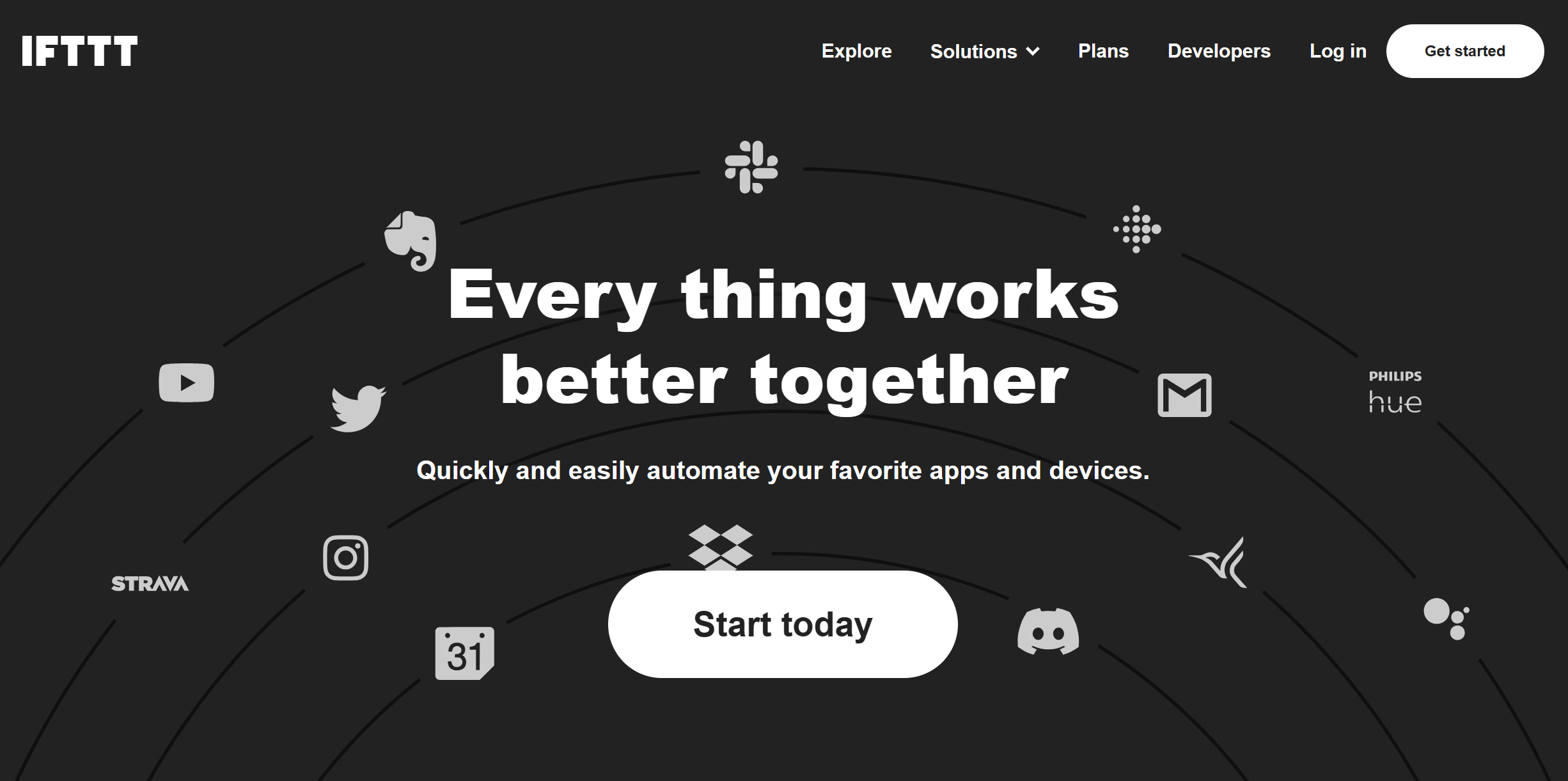"Know yourself, and know your enemy." - Sun Tzu.
In today's fiercely competitive business landscape, staying ahead of the curve is crucial for success. One powerful strategy that can give businesses a significant advantage is competitor analysis. Understanding your competitors' strengths, weaknesses, and strategies enables you to make informed decisions, capitalize on market opportunities, and differentiate your brand effectively.
But what exactly is competitor analysis? Why is it essential for your business? And how can you leverage it to gain a competitive edge? In this article, we will delve into the world of competitor analysis and explore its significance in the modern business environment. To wrap up, we'll introduce IFTTT, our automation service that can help you uncover further insights about your competitors easier than ever.
What is competitor analysis; a Definition

Competitor analysis, often known as competitive analysis, is a strategic process that involves researching and evaluating your industry competitors. The primary goal is to gain valuable insights into their products, services, marketing strategies, and overall business operations.
By conducting strong competitor analysis, businesses can identify their strengths and weaknesses relative to their competitors, understand market trends, uncover new opportunities, and develop effective strategies to stay ahead in the competitive landscape.
Sounds like something your company or startup desperately needs? Keep reading to find out exactly why competitor analysis works and how to conduct it yourself.
Importance of conducting competitor analysis

All over the world, the top companies are the ones that consistently monitor their competitors’ actions and use them to adjust their own strategies for success.
The importance of competitor analysis is two-fold:
1) It enables businesses to stay ahead of the competition and keep up with market trends; 2) It helps companies identify new opportunities for growth.
By understanding their competitors’ strategies, companies are better positioned to create a competitive advantage and capitalize on opportunities in the market. A business that fails to monitor its competitors is at risk of falling behind and losing out on potential revenue.
Objectives and benefits of competitor analysis

Competitor analysis serves various objectives and offers numerous benefits to businesses. Here are some key objectives and benefits of conducting competitor analysis:
Identify competitive threats: By analyzing your competitors, you can identify potential threats they pose to your business. This includes identifying new market entrants, emerging trends, and disruptive technologies that may impact your industry.
Understand market positioning: Competitor analysis helps you understand how your competitors position themselves in the market. This includes their target audience, unique selling propositions, and branding strategies. By gaining insights into their positioning, you can refine your own strategies to differentiate your brand effectively.
Uncover strengths and weaknesses: Evaluating your competitors allows you to identify their strengths and weaknesses. By understanding their strengths, you can learn from their successful strategies and incorporate them into your own approach. Similarly, by identifying their weaknesses, you can capitalize on those areas to gain a competitive advantage.
Identify market opportunities: Competitor analysis helps you identify untapped market opportunities. By studying your competitors' product offerings, marketing campaigns, and customer feedback, you can identify gaps in the market that you can exploit to create innovative products or services.
By learning and implementing these benefits, you are guaranteed to start tipping the business scales your way.
Steps to perform effective competitor analysis

A. Identify your competitors
Direct competitors: These are the companies that offer similar products or services to your business. It’s important to identify as many direct competitors as possible, because these other entities are fulfilling the same consumer need as you are.
Indirect competitors: This refers to companies that offer products or services in the same market as your business, but meet different customer needs. Identifying indirect competitors can provide you with valuable insights into how customers perceive your product or service and can help you target new markets.
B. Gather information about your competitors
Once you have identified your competitors, the next step is to research them and uncover valuable insights. Here’s what you should look for:
1) A list of product or service offerings 2) What are their pricing models? 3) Who are the biggest customers and target market? 4) Identify distribution channels 5) Crucial branding strategies 6) Advertising campaigns and promotions
A helpful tip when gathering this data is to lay it all out in a spreadsheet or document, which allows you to see all of the results on a single page or graph.
C. Analyze and interpret the gathered data
Strengths and weaknesses After gathering data on your competitors, it's crucial to analyze their strengths and weaknesses. This analysis helps you understand what your competitors excel at and where they may be lacking.
First, evaluate the quality of your competitors' products or services. Identify any unique features or benefits they offer that give them a competitive advantage. Determine how they are perceived by customers and whether they have established a strong brand presence.
Look for information on customer reviews, ratings, and feedback regarding your competitors' products or services. Identify areas where they excel in customer satisfaction and areas where they may fall short.
Research your competitors' pricing strategies. Determine if they offer lower prices, premium pricing, or any other pricing models that may give them a competitive edge.
Opportunities and threats
Besides strengths and weaknesses, it's vital to identify the opportunities and threats present in the market. This analysis helps you understand potential areas for growth and the external factors that may impact your business
Try to identify emerging trends and changes in consumer behavior that may present opportunities for your business. Stay updated on industry reports, market research, and customer preferences to capitalize on these trends.
Don't forget any regulations or legal changes that may impact your industry or competitors. Stay informed about industry-specific laws and compliance requirements to navigate potential threats or seize regulatory advantages.
Lastly, but very importantly, make sure to analyze the actions and strategies of your competitors to identify potential threats. Look for any aggressive marketing campaigns, new product launches, or strategic partnerships that may impact your market position.
D. Draw insights from the analysis
Insights can vary depending on the goal of the analysis, but here are a few common ideas. 1. Identifying market trends 2. Uncovering gaps in the market 3. Identifying potential growth opportunities
Tools and resources for competitor analysis

Market research reports: Market research reports provide valuable insights into industry trends, market dynamics, and competitor analysis. Reports from reputable research firms can provide comprehensive data and analysis on competitors.
Website analytics tools: Google Analytics and SimilarWeb can provide information on competitor website traffic, visitor demographics, engagement metrics, and popular keywords they rank for.
Social media monitoring tools: Platforms such as Hootsuite, Sprout Social, and Brandwatch allow you to monitor and analyze your competitors' social media presence. You can track their follower count, engagement rates, content strategy, and customer sentiment.
Keyword Research Tools: Tools like SEMrush, Ahrefs, and Moz can help you identify the keywords your competitors are targeting in their search engine optimization (SEO) efforts. This enables you to structure your market research and identify potential keyword gaps.
Competitor analysis made easy with IFTTT

IFTTT is our powerful automation service that allows you to create connections between different apps and services. While IFTTT can be useful for various tasks, it is not specifically designed as a tool for competitor analysis. However, we host automation for everything from keyword research to email marketing, meaning you are bound to find something perfect for your business growth journey.
Read on to hear our mission, and how you can streamline hundreds of personal and business tasks with the click of a button.
What is IFTTT?
IFTTT, which stands for "If This Then That", is our free web-based service used to create chains of simple conditional commands, called applets.
An applet is triggered by changes that occur within other web services such as Gmail, Facebook, Instagram, or even smart home devices like Google Home. IFTTT allows these services to work together, creating scenarios such as automatically saving email attachments to cloud storage, sharing posts across social media platforms, or turning on your lights when you arrive home.
IFTTT connects over 800 different apps, devices, and services to automate a wide range of tasks, making everyday processes that much more efficient. So, what are you waiting for? Try IFTTT today for free!
Best Applets for competitor analysis

Link Twitter to Spreadsheet: Twitter can be a great source of information for competitor analysis, and this Applet can help you harness it. Configure this Applet to track tweets from your competitors or any mentions of them. These tweets will be automatically added to a Google Spreadsheet, allowing you to easily review and analyze your competitor's Twitter activity and how the public is engaging with them.
Instagram Hashtag to Spreadsheet: This applet automatically saves any Instagram photos with a specific hashtag to a Google Spreadsheet. This can be handy for tracking your competitors' marketing campaigns on Instagram.
RSS to Pocket Applet: If your competitor has a blog and you're using an RSS reader to keep track, this applet automatically saves new RSS feed entries to your Pocket account for reading later.
This is by no means an exhaustive list, and you can check out millions more Applets by signing up for IFTTT today!


